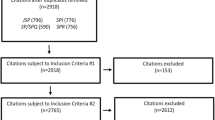Abstract
Following Haring's (1992) recommendation, we have utilized qualitative research techniques to assist us in designing a program of research on inclusive education which is responsive to the outcome values and priorities identified by teachers and parents. Using interviews, observations, and document analysis to follow 35 children in full inclusion classrooms over a period of two years, we have described outcomes for these children in three major domains. These outcome domains, and subthemes within them, have been evaluated and revised based on interviews and social validation ratings by parents and teachers. Dependent measures based on our qualitative research findings are currently being used in a series of behavior analytic studies designed to evaluate the effects of specific interventions on outcomes of inclusion for children with and without disabilities.
Similar content being viewed by others
References
Baer, D. M., Wolf, M., & Risley, T. (1987). Some still current dimensions of applied behavior analysis.Journal of Applied Behavior Analysis, 20, 313–327.
Bogdan, R., & Bilden, S. (1992).Qualitative research in education (2nd ed.). Boston: Allyn & Bacon.
Brown, L., Branston-McClean, M., Baumgart, D., Vincent, L., Falvey, M., & Schroeder, J. (1979) Using the characteristics of current and subsequent least restrictive environments in the development of curricular content for severely handicapped students.AAESPH Review, 4, 407–424.
Ferguson, D. (1993). Something a little out of the ordinary: Reflections on becoming an interpretivist researcher in special education.Remedial and Special Education, 14, (4), 35–43.
Fiske, A. (1992) The four elementary forms of sociality: Framework for a unified theory of social relations.Psychological Review, 99, 689–723.
Gallucci, C. (in preparation).Inclusion from a classroom teacher's viewpoint: A case study. Vancouver, WA: Washington State University.
Glesne, C., & Peshkin, A. (1992).Becoming qualitative researchers: An introduction. White Plains, NY: Longman.
Greenwood, C. R., Carta, J. J., Hart, B., Kamps, D., Terry, B., Arreaga-Mayer, C., Atwater, J., Walker, D., Risley, T. R., & Delquadri, J. C. (1992). Out of the laboratory and into the community: 26 years of applied behavior analysis at Juniper Gardens Children's Project.American Psychologist, 47, 1464–1474.
Haring, T. G., (1992, December).Comments on the current status of research on severe disability. Acceptance speech given at the Annual Conference of the Association for Persons with Severe Handicaps. San Francisco, CA.
Jacob, E. (1987). Qualitative research traditions: A review.Review of Educational Research, 57, 1–50.
Lincoln, Y. S., & Guba, E. G. (1985).Naturalistic inquiry. Beverly Hills, CA: Sage Publications.
Miles, M., & Huberman, M., (1993).Qualitative data analysis: A sourcebook of new methods. Beverly Hills, CA: Sage Publications.
Mishler, E. G. (1979). Meaning in context: Is there any other kind?Harvard Educational Review, 49, 1–19.
Peck, C. (1993). Ecological perspectives on the implementation of integrated early childhood programs. In C. A. Peck, S. L. Odom, & D. D. Bricker (Eds.),Integrating young children with disabilities into community programs (pp. 3–15). Baltimore: Brookes.
Peck, C. A., Donaldson, J., & Pezzoli, M. (1990). Some benefits nonhandicapped adolescents perceive for themselves from their social relationships with peers who have severe handicaps.Journal of the Association for Persons with Severe Handicaps, 15, 241–249.
Peck, C. A., & Furman, G. C. (1992). Qualitative research in special education: An evaluative review. In R. Gaylord-Ross & J. Campione (Eds.),Issues and research in special education: Vol. II. (pp. 1–42). New York: Teachers College Press.
Peck, & Gallucci, C. (1991)Project MESH: A case study of inclusive education. Unpublished manuscript. Olympia, WA: Office of the Superintendent of Public Instruction.
Peck, C., Killen, C., & Baumgart, D. (1989) Increasing implementation of special education instruction in mainstream preschools: Direct and generalized effects of nondirective consultation.Journal of Applied Behavior Analysis, 22, 197–210.
Peck, C., Schwartz, I., Staub, D., Gallucci, C., White, O., & Billingsley, F. (1993, November).Outcomes of inclusive education for children with moderate and severe disabilities: A two year follow-along study. Paper presented at the annual conference of The Association for Persons with Severe Handicaps. Washington, D.C.
Peck, C. A., White, O. R., Billingsley, F., & Schwartz, I. S. (1992).The inclusive education research project: Toward an empirical understanding of process and outcomes associated with the education of children with moderate and severe disabilities in regular classrooms. OSEP Grant Proposal.
Schnorr, R. (1990) Peter? He comes, he goes.Journal of the Association for Persons with Severe Handicaps, 15, 231–240.
Schwartz, I. S., & Baer, D. M. (1991). Social validity assessments: Is current practice state of the art?Journal of Applied Behavior Analysis, 24, 189–204.
Sidman, M. (1960).Tactics of scientific research. New York: Basic Books.
Stainback, S., Stainback, W., & Forest, M. (1989).Educating all students in the mainstream of regular education. Baltimore, MD: Brookes.
Staub, D., Schwartz, I., Gallucci, C., & Peck. C. (in press). Four portraits of friendship in an inclusive school.Journal of the Association for Persons With Severe Handicaps.
Staub, D., Gallucci, C., Billingsley, F. & Schwartz, I. (in preparation).Facilitating inclusion through nondisabled peers: Direct and generalized effects of nondirective consultation. University of Washington: Experimental Education Unit.
Author information
Authors and Affiliations
Rights and permissions
About this article
Cite this article
Schwartz, I.S., Staub, D., Gallucci, C. et al. Blending qualitative and behavior analytic research methods to evaluate outcomes in inclusive schools. J Behav Educ 5, 93–106 (1995). https://doi.org/10.1007/BF02110216
Issue Date:
DOI: https://doi.org/10.1007/BF02110216




